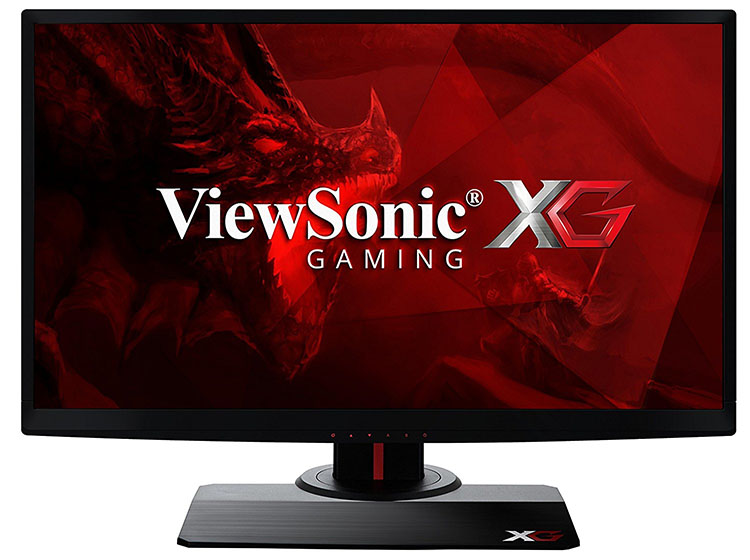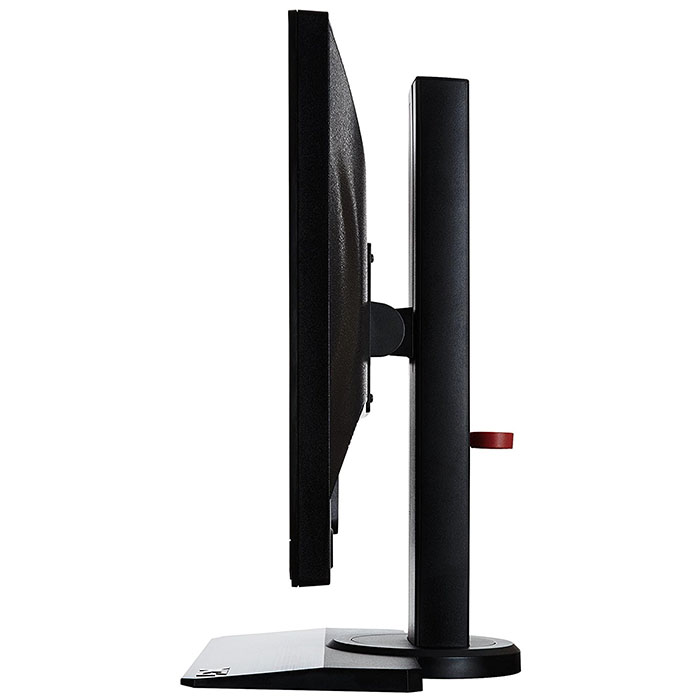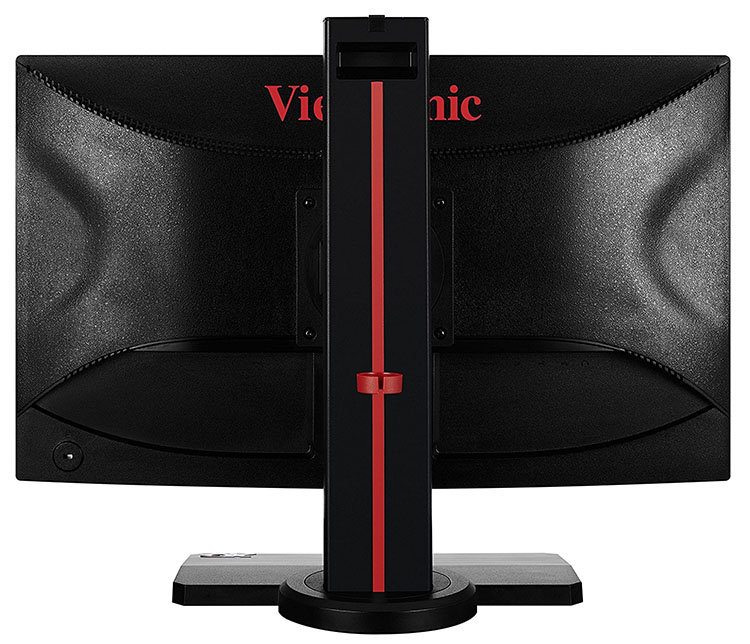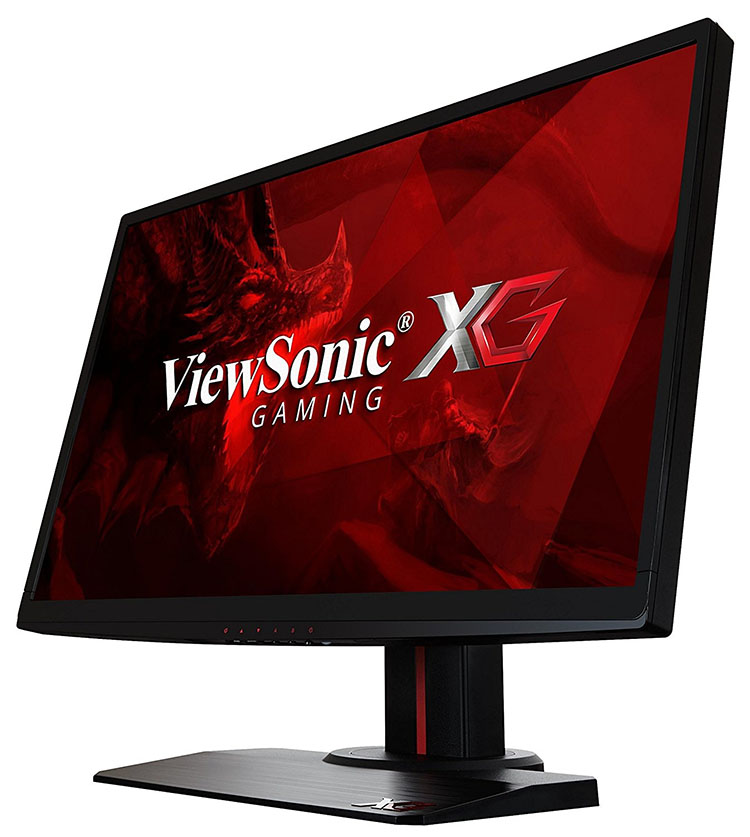Early Verdict
Do we wish the XG2530’s gaming performance were available with Ultra HD resolution and 5000:1 contrast? Of course we do. But that just isn’t a reality at the moment. What ViewSonic is offering here is extreme refresh speed and unparalleled response. The compromise comes in resolution and panel technology but those things don’t lessen the gaming experience one bit. But don’t just take our word for it. Try one yourself and see. We don’t think you’ll want to go back once you do.
Pros
- +
Great out-of-box color
- +
Good build-quality
- +
Feature-rich
- +
FreeSync support
- +
240Hz refresh
Cons
- -
Contrast could be better
- -
Overly-complex OSD
Why you can trust Tom's Hardware
Features & Specifications
AU Optronics’ fast 25” panel has found its way into every major manufacturer’s gaming monitor line. We’ve already tested four of these speed demons and found that they offer the ultimate in smooth motion and lightning quick response. Despite their low FHD resolution and old-school TN screen, there are no other monitors that can make the game an extension of the player’s mind more so than these.
Asus, Alienware, AOC, and Acer have already checked this box; now it’s ViewSonic’s turn. And like the AOC AG251FZ we reviewed recently, the XG2530 featured today has AMD FreeSync as its adaptive-refresh tech of choice. Boasting some impressive specs, this monitor has the most packed OSD we’ve ever seen. With multiple gaming modes and a huge number of options for customization, it almost requires its own seminar to figure out. Hopefully by the time you’re done reading this review, it’ll all make sense. Let’s take a look.
Specifications
The XG2530 seems a bit daunting at first, but once you peel away the layers, it’s no different than any other 25” 240Hz gaming monitor. Of the five we’ve had so far, it and AOC's are the only ones supporting FreeSync. Asus, Acer, and Alienware employ Nvidia’s G-Sync technology. ViewSonic is taking full advantage of the spec by keeping adaptive-sync alive all the way down to 24Hz. While this is admirable, one would need a seriously old video card to run a game that slowly at only 1920x1080 pixels.
Of course, FreeSync means two things, a lower price and no blur reduction. Though we’ve seen the backlight strobe on a couple of FreeSync monitors, it is typically only found in G-Sync products. This might be an issue for some hardcore gamers, but in our experience adaptive refresh always provides a better experience than blur reduction. And the price? It’s about $130 lower than Asus, Acer, and Alienware at this writing.
What all five products share is the same AU Optronics part. Developed at the urging and guidance of Nvidia, this panel pretty much makes input lag non-existent and provides perfectly smooth motion at some insanely high framerates. With a premium video card, it’s not difficult to top 200 FPS at max detail. That’s something worth experiencing.
Packaging, Physical Layout & Accessories
ViewSonic’s packaging is always top quality, and we’ve never seen so much as a scratch on anything the company has sent us. The carton is double corrugate and opens from the top. The upright is already bolted onto the panel for you; just attach the base with its captive fastener. Build quality is solid, a fact that proves itself the moment you handle the XG2530. Bundled cables include an IEC power cord, DisplayPort, and USB 3.0. You also get a printed quick-start guide. Further documentation can be found on ViewSonic’s website.
Product 360




ViewSonic has never been one to apply a lot of extra design elements to its gaming monitors. The XG2530 has the same purposeful and industrial look as its business-oriented counterparts. To set the XG line apart, you’ll find a few bits of red trim and some textures here and there but nothing like the sci-fi feel you see with Asus’ ROG displays.
Get Tom's Hardware's best news and in-depth reviews, straight to your inbox.
The bezel isn’t especially narrow or wide, it’s just about right. If you want a frameless design, the XG2530 isn’t it, and it makes no attempt to be. The frame and surrounding plastic is tough and nicely finished to prevent any reflection from ambient light. That feature extends to the anti-glare layer, which keeps all but the brightest sources at bay. We couldn’t see any graininess in either finely detailed gaming environments or small text.
From the front, the only identifying mark is a large XG logo on the base. “ViewSonic” is printed in big red letters around back. The controls are in the center and consist of down-facing buttons and tiny icons. The far-left one pops up picture mode selection, and the rest engage and navigate the vast OSD.
The base and stand are nearly bomb-proof and move with just the right amount of resistance. Height is adjustable through a 4.6” range, and you get 45° swivel in each direction, 15° back and 5° forward tilt, and a portrait mode with rotating OSD.
Despite a little chunkiness in the overall shape, the side profile is slim at just 2.3”. You can see a small cable management ring in the photo. It snaps on the upright and can be omitted if you wish. At the top of the stand is a small pull-out hanger for headphones. The USB ports are unfortunately not found on either side. You’ll have to go underneath for them.
The back has an almost leather-like texture with an organic shape molded into it. In one corner is the requisite Kensington lock. Two three-watt speakers play through the upper grillwork and make decent volume if not a lot of bass. Keep the volume below maximum to avoid distortion.
The input panel includes two HDMI ports, one of which is 2.0-compatible and has HDCP 2.2 content protection. HDMI supports FreeSync up to 240Hz as does the single DisplayPort. One upstream and two downstream USB 3.0 jacks, along with a 3.5mm audio output complete the XG2530’s connectivity.
MORE: Best Gaming Monitors
MORE: Best Professional Monitors
MORE: How We Test Monitors
MORE: How To Choose A Monitor
MORE: All Monitor Content

Christian Eberle is a Contributing Editor for Tom's Hardware US. He's a veteran reviewer of A/V equipment, specializing in monitors. Christian began his obsession with tech when he built his first PC in 1991, a 286 running DOS 3.0 at a blazing 12MHz. In 2006, he undertook training from the Imaging Science Foundation in video calibration and testing and thus started a passion for precise imaging that persists to this day. He is also a professional musician with a degree from the New England Conservatory as a classical bassoonist which he used to good effect as a performer with the West Point Army Band from 1987 to 2013. He enjoys watching movies and listening to high-end audio in his custom-built home theater and can be seen riding trails near his home on a race-ready ICE VTX recumbent trike. Christian enjoys the endless summer in Florida where he lives with his wife and Chihuahua and plays with orchestras around the state.
-
cknobman I'm sorry but no matter how fast the response is I cannot go back to a 1080p resolution now.Reply
I'd rather have the extra resolution. -
RCPG What about the ASUS ROG STRIX XG258Q and the Dell Alienware AW2518Hf? They are also 240Hz monitors with Freesync. Those two (Viewsonic and AOC) are not the only ones and I would like it very much if you could also review those to see which would be the 240Hz Freesync monitor king. I'm thinking about buying one 240Hz Freesync monitor and would like to buy the best. Currently have an AMD R9 390. Planning to upgrade to a Vega 56 or something like that, but only when that becomes affordable. The prices are just too high right now.Reply -
d--anderson Let me know when we have 4K, 32", 120hz+ on a true HDR 10bit colour with 1000nits.Reply
Oh wait, nothing of the sort is available until 2H2018. All we've got is garbage that 'supports' HDR signal input without actually displaying it. -
ElMojoMikeo A 24.5in 1080p is not exciting. To some degree it is obsolete. With 2, 3 and 4K becoming wider spread. The 3 and 4K display would need to be around 32in for daily use. You might get away with 2K at 27in just. So higher resolutions will require larger displays. I think we are seeing this trend as we move forward. I am guessing that a 30ins 2K monitor with free sync could be the new base line.Reply -
ManamalGames Who the hell wants to buy a 1080p monitor at 240hz and 25". Please discontinue this monitor now. It is a waste of money.Reply -
therainbowchannelus Those in favor of higher resolutions... I agree that higher resolution with HDR and 1000 nits of brightness is great, but this monitor is geared towards a specific market of very competitive gamers. Those who play FPS games, etc. If you want to drive a monitor up to 240Hz @2K, you'd need a tech that might not even exist yet. 1080p resolution is there for a purpose. I am sure there will always be a market for this kind of hardware. Just read Amazon reviews on a 144Hz monitors.Reply
I have a 144 Hz monitor (on which colors and contrast look lile garbage) to play Rainbow 6 Siege on, and a separate 4K one so I can enjoy my Forza Horizon 3 in glorious 4K 60. 144Hz monitor gives you the ability to sharpen your skills if you desire to do so. Not everyone can afford that, but there is certainly a market for it. -
ddferrari Reply20613096 said:What about the ASUS ROG STRIX XG258Q and the Dell Alienware AW2518Hf?
Did you even read the review? They were both in the comparison charts.
-
ddferrari Reply
Is this the "cool" thing to do now- proclaim that anything less than the ultimate *whatever* (that doesn't even exist) is beneath your high standards? Here are a few facts to chew on, which apparently you haven't thought about:20613336 said:Let me know when we have 4K, 32", 120hz+ on a true HDR 10bit colour with 1000nits.
Oh wait, nothing of the sort is available until 2H2018. All we've got is garbage that 'supports' HDR signal input without actually displaying it.
a) There's barely any HDR content in any format available right now. You do realize that feeding any old thing into an HDR monitor does not give you an HDR picture, right? The content has to specifically offer HDR support.
b) There is no GPU in existence that can come close to 4K 120Hz. Not even the first gen of Volta will be able to. Certainly nothing from AMD for years to come.
This dream monitor of yours doesn't exist yet for a reason.
-
ddferrari Reply
So it's not for you, therefore it shouldn't exist? Really?20613694 said:Who the hell wants to buy a 1080p monitor at 240hz and 25". Please discontinue this monitor now. It is a waste of money.
-
d--anderson Reply20615148 said:
Is this the "cool" thing to do now- proclaim that anything less than the ultimate *whatever* (that doesn't even exist) is beneath your high standards? Here are a few facts to chew on, which apparently you haven't thought about:20613336 said:Let me know when we have 4K, 32", 120hz+ on a true HDR 10bit colour with 1000nits.
Oh wait, nothing of the sort is available until 2H2018. All we've got is garbage that 'supports' HDR signal input without actually displaying it.
a) There's barely any HDR content in any format available right now. You do realize that feeding any old thing into an HDR monitor does not give you an HDR picture, right? The content has to specifically offer HDR support.
b) There is no GPU in existence that can come close to 4K 120Hz. Not even the first gen of Volta will be able to. Certainly nothing from AMD for years to come.
This dream monitor of yours doesn't exist yet for a reason.
There's heaps of HDR media, even Dolby Vision content (12-bit colour). Many TV's are already capable of the above specs, but monitor tech lags behind tv's.
Not everything is about gaming, or I'd have mentioned input ms as well.
